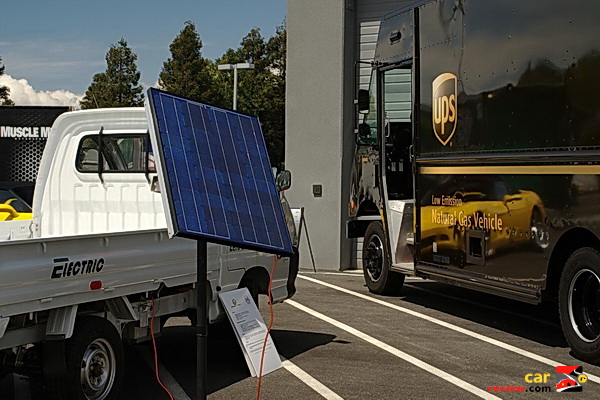 Hybrid cars are expensive and only considered a short term answer towards relieving our dependence upon foreign oil sources. To really decrease America’s dependency and reduce our overall consumption of a non-renewable resource, there are many alternative fuel cars in the pipeline – compressed natural gas, hydrogen, 100% electric vehicles, PHEV, and bio-diesel are the alternative fuels being explored by many car manufacturers and independent companies looking to offer conversions.
Hybrid cars are expensive and only considered a short term answer towards relieving our dependence upon foreign oil sources. To really decrease America’s dependency and reduce our overall consumption of a non-renewable resource, there are many alternative fuel cars in the pipeline – compressed natural gas, hydrogen, 100% electric vehicles, PHEV, and bio-diesel are the alternative fuels being explored by many car manufacturers and independent companies looking to offer conversions.
Alternative fuels, such as compressed natural gas (CNG) and hydrogen fuel cells, are also being tested by many companies. Ford is testing a CNG powered F-150 with a range of 190 miles on 10 gallons of CNG. Taxi cabs are also a target using CNG as a fuel source. On average, a NY taxi cab can run up 50,000 miles a year. Using CNG, this translates into a savings of approximately $38,000.
Large CNG powered fleets, such as UPS, are also seriously looking at large cost savings and reducing tons of hydrocarbons pushed into the atmosphere each year. Less money spent on fuel and less impact on global warming.
Fuel cell vehicles (FCVs) have the potential to significantly reduce our dependence on foreign oil and lower harmful emissions that cause climate change. FCVs run on hydrogen gas rather than gasoline and emit no harmful tailpipe emissions. These vehicles are in the early stages of development, and several challenges must be overcome before these vehicles will be competitive with conventional vehicles. However, the potential benefits of this technology are substantial. Real world examples using fuel cell technology are the Honda FCX Clarity and BMW Hydrogen 7-Series.
Something with an even smaller carbon footprint are zero emission solar powered EV E/Dyne trucks and buses. Imagine fleets of EV delivery trucks and buses that are charged by a plate of photovoltaic cells.
Electric vehicles (EV) are propelled by an electric motor (or motors) powered by rechargeable battery packs. Electric motors have several advantages over internal combustion engines (ICEs):
- Energy efficient. Electric motors convert 75% of the chemical energy from the batteries to power the wheels—internal combustion engines (ICEs) only convert 20% of the energy stored in gasoline.
- Environmentally friendly. EVs emit no tailpipe pollutants, although the power plant producing the electricity may emit them. Electricity from nuclear-, hydro-, solar-, or wind-powered plants causes no air pollutants.
- Performance benefits. Electric motors provide quiet, smooth operation and stronger acceleration and require less maintenance than ICEs.
- Reduce energy dependence. Electricity is a domestic energy source.
Electric-car technology has been supported by U.S. policy makers including President Barack Obama as a way to reduce the nation’s oil use and dependence on foreign energy sources. Obama set a goal of getting 1 million plug-in hybrids and electric cars on U.S. roads by 2015.
EVs and range-extended EVs are becoming mainstream as the more EV cars are scheduled to be released over the next two years. Coming to a dealership near you in the near future are the Nissan Leaf, Chevy Volt, Mitsubishi i-MiEV, Ford Focus EV, and Coda Automotive Sedan.
A PHEV is essentially a regular hybrid with an extension cord and can obtain 100+ mpg. Toyota has embarked on a 18-month trial of PHEVs and has a test fleet of Prius’ out in the field across the world. Various private and public organizations such as Portland State University, Transport for London, and Silicon Valley Leadership Group in San Jose, Calif. were chosen to receive a plug-in Prius and report back the performance of Toyota’s big green machine.
As PHEVs become more mainstream, the movement to build up the infrastructure surrounding electric vehicles continues, not just with the carmakers, but also utility companies, parts suppliers, and third party players offering conversion kits. The 2010 Plug-in Conference, taking place at the San Jose Convention Center July 26 – 29, will showcase current and future plug-in hybrid and electric transportation technologies. The Plug-in conference will cover all critical areas of plug-in vehicles including batteries, vehicles and infrastructure, and discussions will be structured around technology aspects, market research, policy initiatives, and commercialization.
 Plug‑In 2010 Conference & Exposition – www.plugin2010.com Plug‑In 2010 Conference & Exposition – www.plugin2010.com |




Nearly a decade ago electric cars were coming out of GM in droves to satisfy a California mandate to have a certain percentage of electric cars on the road by a certain time. GM would not sell the electric cars; they would only lease them. People loved the cars and many were on the roads running smoothly, efficiently and economically. The oil industry and GM worked to change the law in California. GM recalled all the leases and the company destroyed nearly every car in a crusher.
http://just-me-in-t.blogspot.com/2010/06/quiet-clean-functional-carbonless.html